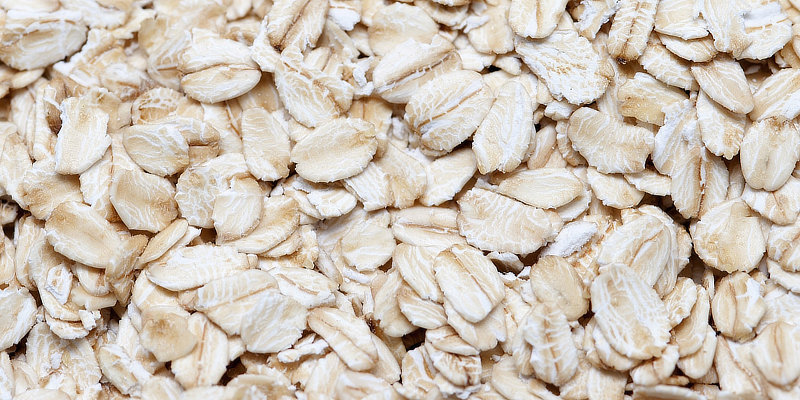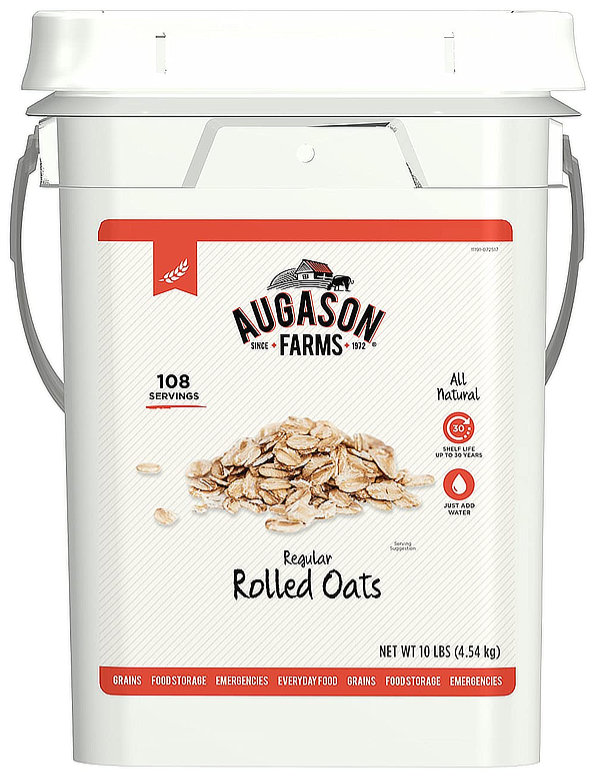Breakfast Food for Emergency Storage – Oats

Breakfast food for emergency / long term storage — and for occasional everyday use. Breakfast food that’s not only a good choice for stocking up for emergency, but also good for normal consumption once in a while! Remember, it’s a good idea to “buy what you eat and eat what you store” when it comes to emergency food storage. That way, you won’t waste it. Eat some regularly, and then rotate/replace it.
Emergency food for breakfast. Lets focus on that meal. I wonder what breakfast foods might store well (for use as an emergency supply), while also being good for normal consumption too. Here are some of my thoughts about that…
Foods have their own shelf life. And it’s usually beyond that which is stamped on the package…but that’s another story (I’ll link an article about it below). One food type (group?) that can be a good choice and last a long time are dry foods. With reference to breakfast food for emergency storage, Oatmeal comes to mind. And you’ve got a number of options…
Oats for Emergency Storage of Breakfast Food
How long does oatmeal last? Well, that depends on specifically what you get, the extent of processing, and how it’s stored. Here’s some info about the topic…
Types of Oats
There are a bunch of different types of oats. And I’m not going to get into the specifics of all that. However, here’s a summary.
Whole grain oats, called groats. It’s the whole oat kernel. Not commonly used compared with the others.
Steel cut oats. They are the least processed of the others. They are made from an automated process of chopping/cutting oat groats into pieces with a steel blade. Steel cut oats take about 20 – 30 minutes to cook, and have a sort of nutty flavor and creamy/slightly-chewy texture.
Old-fashioned rolled oats. They’re quite popular. They look kind of flat. That’s because they’re made from squishing oat groat between steel rollers (after they’re first steamed to make soft). They only take 5 – 10 minutes cooking to produce a creamy soft texture that people have come to know and love.
Instant oats. They are steamed and pre-cooked oat groats that are then dried, rolled, and pressed slightly thinner than rolled oats – then chopped smaller. This processing enables very quick cook times of 1 – 3 minutes. The result is a creamy consistency but can be a bit more mushy / gummy. This type of oat process is commonly used form the many various instant packets with a wide variety of other additives (dried fruits, etc..).
Shelf Life of Oats
Whole grain oat groats can have a very long shelf storage life under the right storage conditions and containment packaging (10 – 30 years!) (e.g. #10 cans, sealed Mylar/buckets with oxygen absorbers). However again, groats aren’t commonly ingested or popular for eating compared to the other oat choices. Groats need a slight bit of processing for edibility.
Steel cut oats will also store very well. And for a long time, likely similar to groats (decade+) under ideal conditions in an oxygen-free environment and good containment. But are steel cut oats a good choice for breakfast food emergency storage? Although they have the potential to store quite well, I don’t like the fact that it takes so long to cook them. That’s a lot of extra energy and fuel consumption compared with the following choices…
Old-fashioned rolled oats are a good choice for emergency storage breakfast food (along with having some instant oats too, which I’ll talk about in a second…). If stored right (referenced above, and/or vacuum-sealed), you’re still likely looking at 10+ years (1 – 2 years with just the store packaging paper/cardboard which lets the air seep in). Some may not agree with me on this choice because steel cut may store better/longer due to a bit less processing. However the extra cooking time is mostly a non-starter in my opinion…
Best Choice of Oats For Breakfast Food Emergency Storage
Actually, two. Lets start with rolled oats. Here’s an example already packaged for long term storage. It’s from Augason Farms, who I use for some of my emergency preparedness food supply.
10 pound bucket
(amzn)

I’ve chosen rolled oats as part of the breakfast foods portion of my overall long term emergency food preparedness. I’m using the 5-gallon bucket method for the long haul.
Rolled oats, straight up, will be a great choice for the long term. Either do it yourself, or buy some pre-packaged for the long haul. That’s assuming you like oats good enough for breakfast :=)
However in addition, and one that I feel is a great choice for a quick-and-easy short term solution to also help mitigate filling your breakfast food emergency needs, is instant oatmeal. The packets are so easy. Yes it’s the most processed, and it won’t last as long either (more if you take the time to store it differently than the store packaging). But if you go through it regularly, it won’t go bad.
Note that commercial processed oatmeal can last up to 1–2 years in normal packaging when kept in a cool, dry place with minimal exposure to moisture, air and light. However bear in mind that most flavored/cream-variety instant oatmeal (depending on what they add to the packet ingredients) will likely have a shorter shelf life / expiration. Maybe even 6 months. So be aware that some instant oatmeal packs may have varying shelf life expectancies. Again, read my article about ‘best purchased by’ dates, linked below.
Your kids will love it… (maybe)
Got kids at home? Chances are they’ll eat some of this (yes, the packets typically have sugar added too). There’s quite an array of yummy instant oatmeal packets that you can get. You might simply buy a bunch of boxes and set it aside for emergency. But don’t forget about them… use them up over a period of time – while replacing what you consume so you’ll always have an emergency breakfast food inventory!
It might make sense for the prepper to keep some rolled oats packaged for the long haul. But also, keep some at the ready for occasional daily use too. Your opened ‘ready’ supply won’t store as long (because it’s opened up and exposed to air and elements), but it will still be fine for a year or more afterwards. You might choose a container for everyday use – but with a decent airtight lid for in-between use.
An example of two decent container choices for everyday use, and made in the USA, are (this one) or (this one) as viewed on their storefront at amzn.
Okay, this has been a focus on oats for breakfast. There are other breakfast food for emergency storage options too! Lets hear your opinions on this topic…
[ Read: Best-by, Use-by, Expiration Dates on Food Packaging ]
[ Read: Taste Some Of Your Long Term Food Storage To See If It’s Any Good ]
